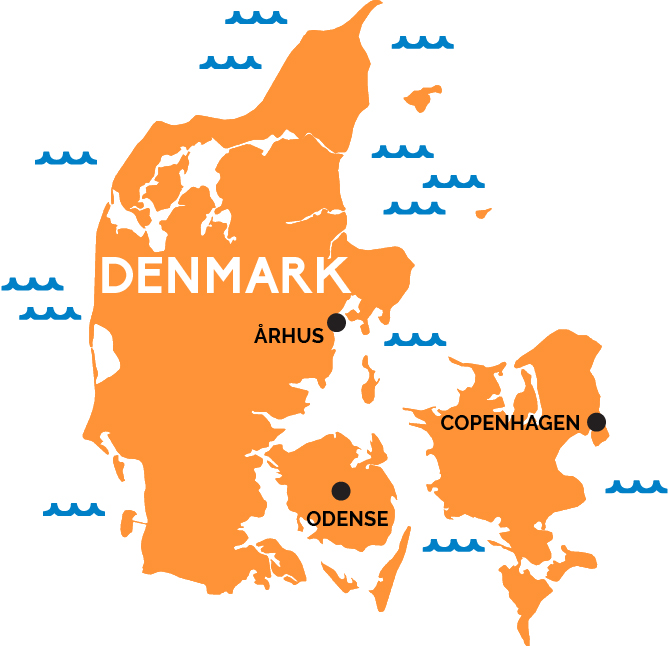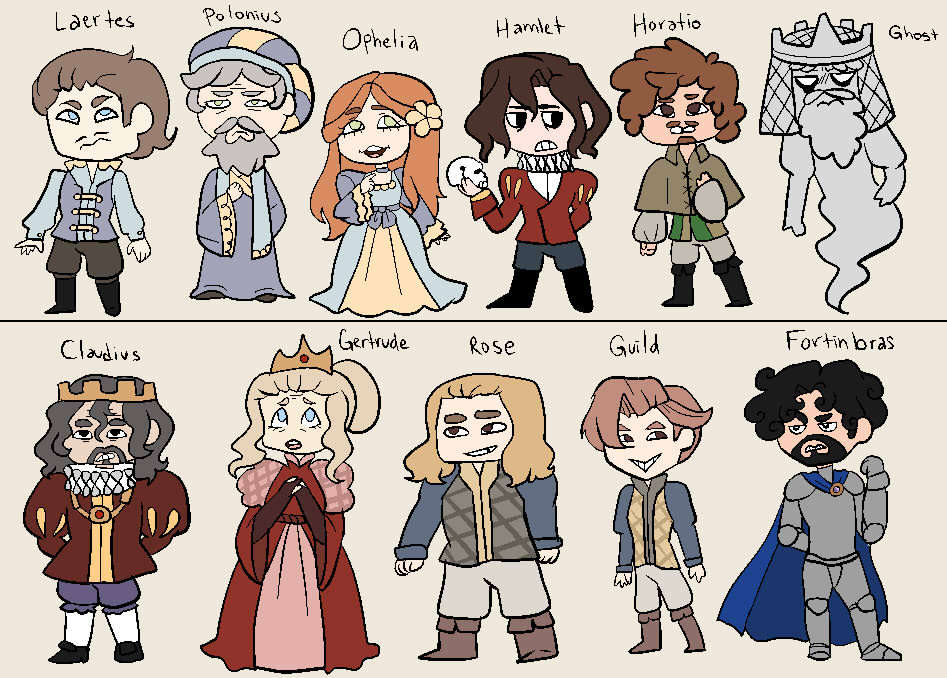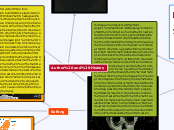
Themes & Motifs
Action vs Inaction:
Hamlet is asked to take action (to kill King Claudius) by the ghost, but he struggles to do so. He debates his options and hatches a
plan to verify the Ghost’s story first. Once he is certain of the king’s guilt, Hamlet seems ready to act, but, yet again, opts against doing so when he hesitates to kill the king while the monarch appears to be praying. Hamlet’s inaction is contrasted with the two other men who have also lost their fathers: Laertes and Fortinbras. Both of these men are of quick resolve and action.
Madness:
His madness begins as a ruse to elude the suspicious king and his prying spies, Polonius, Rosencrantz and Guildenstern, and to be left free to investigate the truth of the claims made by the Ghost. As the play develops, however, and Hamlet remains stuck in his own confusion and inaction, there are times where he appears to stray into genuine madness and doubts arise about the actual soundness of his mind. The theme of madness also informs the character of Ophelia. Overwhelmed by her grief at her father’s sudden death,
she appears to lose her grip on reality and wanders about, singing songs and handing out flowers.
Honour and Revenge:
Closely related to revenge is the idea of honour. Hamlet’s duty to avenge his father is tied to his honour as a ‘good son’. When speaking to the Ghost, for example, Hamlet declares, ‘Speak, I am bound to hear’, to which the Ghost responds: ‘So art thou to revenge, when thou shalt hear’ (Act 1, Scene 5, lines 10-11). This exchange highlights the relationship between revenge and honour, and the accepted duty of a son to take revenge on behalf of his father. This theme is emphasized and expanded through the inclusion of Laertes and Fortinbras as well, two other sons who feel it is their duty to avenge their fathers’ deaths.
Disease and Decay:
Images of decay and disease are used repeatedly throughout the play. These images relate to the corrupt state of Denmark as a result of the unnatural death of the old king and unnaturally quick marriage of the queen to her dead husband’s brother. The idea is that the moral fabric of society is rotting because of the dishonest and corrupt behaviour of the leaders of
the nation. The king is a usurper who ‘stole’ the throne dishonestly and this corrupt state of affairs is compounded by the queen’s swift decision to marry her husband’s brother. This is contrasted with the ascension of young Fortinbras to the throne at the end of the play. The audience is given a glimpse of a hopeful future in which the country might begin to heal.
Appearance vs Reality:
This theme is also reflected in all of the plotting by the characters. Almost all of the schemes are, ultimately, attempts to uncover what other characters are really thinking and doing since nearly everyone in the play is hiding his or her true feelings and intentions. The king and Polonius are trying to figure out what might lurk beneath Hamlet’s madness, for instance, while the prince is feigning the appearance of madness to obscure his secret mission to reveal the king’s true murderous nature and to kill his deceitful uncle. The Ghost is another investigation of this theme. Is it an apparition, is it real or is it somehow both? It appears to be the previous king, but can its appearance be trusted? The sensational claims made by the Ghost appear to contradict reality, but the Ghost is, in fact, exposing Hamlet to the real truth.

Characters
Gertrude:
The Queen of Denmark, Hamlet's mother who recently got married to Claudius.
Horatio:
Hamlet's close friend, who studied with the prince at the university in Wittenberg.
Laertes:
Polonius's son and Ophelia's brother, a young man who spends much of the play in France.
Fortinbras:
The young Prince of Norway, whose father the king (also named Fortinbras) was killed by Hamlet’s father (also named Hamlet).
Hamlet:
The Prince of Denmark, the title character, and the protagonist.
Claudius:
The King of Denmark, Hamlet's uncle, and the play's antagonist.
Ophelia:
Polonius's daughter, a beautiful young woman with whom Hamlet has been in love with.
Polonius:
The Lord Chamberlain of Claudius's court, a pompous conniving old man, while being the father of Laertes and Ophelia.
The Ghost:
The specter of Hamlet’s recently deceased father. The ghost, who claims to have been murdered by Claudius, calls upon Hamlet to avenge him.
Rosencrantz and Guildenstern:
Two slightly bumbling courtiers, former friends of Hamlet from Wittenberg, who are summoned by Claudius and Gertrude to discover the cause of Hamlet’s strange behavior.
Osric:
The foolish courtier who summons Hamlet to his duel with Laertes.
Voltimand and Cornelius:
Courtiers whom Claudius sends to Norway to persuade the king to prevent Fortinbras from attacking.
Marcellus and Bernardo:
The officers who first see the ghost walking the ramparts of Elsinore and who summon Horatio to witness it.
Francisco:
A soldier and guardsman at Elsinore.
Reynaldo:
Polonius's servant, who is sent to France by Polonius to check up on and spy on Laertes.
Relationships

Symbolism & Imagery
Yorick's skull:
The appearance of Yorick’s skull in the final act of the play symbolises death and its inevitability. Hamlet knew Yorick, the court jester, as a child and his fond memories of the man lead him to ponder the idea that death serves as an equaliser among people, whether rich or poor, good or bad, lower class or highborn.
Ophelia's Flowers:
The tragic scene during which Ophelia hands out flowers exploits the symbolism of the flowers. The rosemary she gives to Laertes represents remembrance and was traditionally worn at weddings and funerals, as well as allow the reader to imagine this scene.

The 'Play within a Play':
The modified version of The Murder of Gonzago — the play within the play — also serves as a symbol for the actualmurder of the old King Hamlet by King Claudius.
Setting
In Hamlet, there are numerous references made to other countries which include France, Germany, Norway, Poland and England. Despite these locations, the majority of the play occurs in and around Elsinore Castle, located in Denmark. Another scene which demonstrates the significance of setting is the graveyard scene. In this specific scene, Hamlet to espouses his existential ideas on the meaning (or lack thereof) of life in a graveyard, surrounded by bones of the dead. There is not a place more ideal for this event to happen.


Author and History
William Shakespeare was an English poet and playwright who is considered one of the greatest writers to ever use the English language. He is also the most famous playwright in the world, with his plays being translated in over 50 languages and performed across the globe for audiences of all ages. Known colloquially as "The Bard" or "The Bard of Avon," Shakespeare was also an actor and the creator of the Globe Theatre, a historical theatre, and company that is visited by hundreds of thousands of tourists every year.

